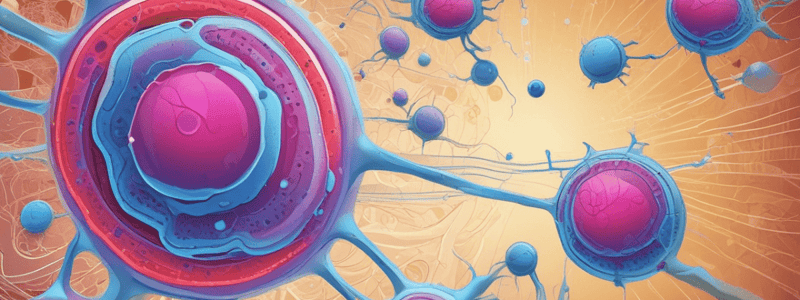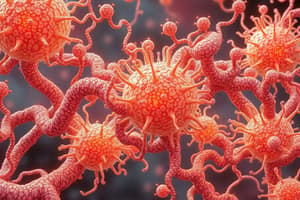Podcast
Questions and Answers
What is a characteristic of embryonic stem cells?
What is a characteristic of embryonic stem cells?
- They are only found in adult tissues.
- They are pluripotent and can give rise to all types of cells in the body. (correct)
- They are unipotent and can differentiate along one cell line only.
- They are multipotent and can only give rise to a limited number of cell types.
What is the main difference between pluripotent and multipotent stem cells?
What is the main difference between pluripotent and multipotent stem cells?
- Pluripotent stem cells can give rise to all types of cells, while multipotent stem cells can only give rise to a limited number of cell types. (correct)
- Pluripotent stem cells are more likely to form teratomas than multipotent stem cells.
- Multipotent stem cells are more capable of self-renewal than pluripotent stem cells.
- Pluripotent stem cells are only found in embryonic development, while multipotent stem cells are found in adult tissues.
What is the primary function of progenitor cells?
What is the primary function of progenitor cells?
- To undergo asymmetric division and give rise to more stem cells.
- To undergo self-renewal and maintain a pool of stem cells.
- To form teratomas in vivo.
- To differentiate into other mature cell types. (correct)
What is a characteristic of induced pluripotent stem cells (iPSCs)?
What is a characteristic of induced pluripotent stem cells (iPSCs)?
What is a marker of pluripotent stem cells?
What is a marker of pluripotent stem cells?
What is the primary characteristic of unipotent stem cells?
What is the primary characteristic of unipotent stem cells?
What is a characteristic of adult stem cells?
What is a characteristic of adult stem cells?
What is teratoma formation?
What is teratoma formation?
Where are some cells trapped during the two migration waves?
Where are some cells trapped during the two migration waves?
What is the origin of Mesenchymal Stem Cells (MSCs) in Umbilical Cord Blood?
What is the origin of Mesenchymal Stem Cells (MSCs) in Umbilical Cord Blood?
Which of the following is not a characteristic of Umbilical Cord Blood MSCs?
Which of the following is not a characteristic of Umbilical Cord Blood MSCs?
What is the origin of Dental Mesenchymal Stem Cells?
What is the origin of Dental Mesenchymal Stem Cells?
What is a characteristic of Amniotic Fluid Stem Cells?
What is a characteristic of Amniotic Fluid Stem Cells?
Which of the following is a type of Dental Stem Cell?
Which of the following is a type of Dental Stem Cell?
What is a characteristic of Cancer Stem Cells?
What is a characteristic of Cancer Stem Cells?
Where are Stem Cells from Human Exfoliated Deciduous Teeth (SHED) derived from?
Where are Stem Cells from Human Exfoliated Deciduous Teeth (SHED) derived from?
What is the percentage of surface antigens required for mesenchymal stem cells according to the International Society of Cellular Transplant (ISCT)?
What is the percentage of surface antigens required for mesenchymal stem cells according to the International Society of Cellular Transplant (ISCT)?
Which of the following is NOT a characteristic of hematopoietic stem cells?
Which of the following is NOT a characteristic of hematopoietic stem cells?
What is the primary cell population in Umbilical Cord Blood?
What is the primary cell population in Umbilical Cord Blood?
What is the characteristic of adipose-derived stem cells?
What is the characteristic of adipose-derived stem cells?
Where do hematopoietic stem and progenitor cells reside?
Where do hematopoietic stem and progenitor cells reside?
What is the characteristic of mesenchymal stem cells?
What is the characteristic of mesenchymal stem cells?
During embryogenesis, where do HSCs and MSCs migrate to from the yolk sac and aorta-gonad-mesonephros?
During embryogenesis, where do HSCs and MSCs migrate to from the yolk sac and aorta-gonad-mesonephros?
What is the characteristic of Umbilical Cord Blood compared to Adult Peripheral Blood?
What is the characteristic of Umbilical Cord Blood compared to Adult Peripheral Blood?
What are the four Yamanaka factors that are used to induce pluripotency in cells?
What are the four Yamanaka factors that are used to induce pluripotency in cells?
What is the main difference between embryonic stem cells and adult stem cells?
What is the main difference between embryonic stem cells and adult stem cells?
Which of the following stem cells is derived from the mesoderm?
Which of the following stem cells is derived from the mesoderm?
What is the main function of trophic support in Mesenchymal Stem Cells?
What is the main function of trophic support in Mesenchymal Stem Cells?
Which of the following is NOT a characteristic of Hematopoietic Stem Cells?
Which of the following is NOT a characteristic of Hematopoietic Stem Cells?
What is the main difference between Oct4 and c-Myc?
What is the main difference between Oct4 and c-Myc?
What is the main location of Mesenchymal Stem Cells?
What is the main location of Mesenchymal Stem Cells?
What is the main difference between Induced Pluripotent Stem Cells (iPSCs) and Embryonic Stem Cells?
What is the main difference between Induced Pluripotent Stem Cells (iPSCs) and Embryonic Stem Cells?
Flashcards are hidden until you start studying
Study Notes
Stem Cells
- Stem cells are unspecialized cells with the capacity for self-renewal, asymmetric division, and transformation into other mature cell types.
- They can be classified into embryonic stem cells, adult stem cells, and induced pluripotent stem cells.
Embryonic Stem Cells
- Derived from the inner cell mass of developing blastocysts.
- Pluripotent stem cells, capable of differentiating into all three germ layers: ectoderm, endoderm, and mesoderm.
- Self-renewal in-vivo and in-vitro.
- Pluripotency stem cell markers include OCT3/4, Nanog, Sox2, SSEA4, TRA1-81, and TRA1-60.
- Can form teratomas, which are tumors that contain cells from all three germ layers.
Adult Stem Cells
- Also referred to as somatic stem cells.
- Not entirely "adult," but rather "post-embryonic" stem cells.
- Mostly multipotent, rather than pluripotent.
- Limited differentiation potential.
- Capacity for self-renewal.
- Examples include hematopoietic stem cells (HSCs) and mesenchymal stem cells (MSCs).
Mesenchymal Stem Cells
- Multipotent stem cells.
- Traditionally found in red bone marrow (stromal MSC).
- Can be isolated from other tissues, such as adipose tissue, peripheral blood, umbilical cord blood, and dental tissues.
- Differentiation potential includes adipocytes, chondrocytes, tenocytes, osteocytes, and myocytes.
- Surface antigens according to the International Society of Cellular Transplant (ISCT) include CD105, CD73, CD90, and CD45.
- Can be isolated using affinity for plastic adherence.
- Easy in-vitro expansion.
- High plasticity.
- Immune privileged.
- Immunomodulatory effects via cytokine secretion.
Hematopoietic Stem Cells
- Multipotent stem cells.
- Derived from mesoderm.
- Able to give rise to all blood cells (lymphoid, myeloid).
- Located in adult bone marrow, peripheral blood, and umbilical cord blood.
- Limited transdifferentiation potential (muscle, liver, bone).
Induced Pluripotent Stem Cells
- Genetically modified adult cells to resemble embryonic-like stem cells.
- May substitute for embryonic stem cells.
- Discovered in 2006 by Prof. Yamanaka and Takahashi, Nobel Prize.
- Potential for mutagenesis.
- Yamanaka factors include Oct4, Sox2, Klf4, and c-Myc.
- Highly expressed in embryonic stem cells.
- Developmental signaling network of embryonic stem cells.
- Determinant of embryonic stem cell pluripotency.
Umbilical Cord Blood
- Primary cell population includes lymphocytes and monocytes.
- Higher natural killer (NK) population.
- Lower T-lymphocyte population.
- Higher proportion of immature T-lymphocytes.
- Lower absolute numbers of cytokines.
- Presumption: higher ratio of anti- vs. pro-inflammatory cytokines.
- Low immunogenic cells.
- HSCs and MSCs migrate from the yolk sac and aorta-gonad-mesonephros to the placenta and then back to the fetal liver and bone marrow through the umbilical cord.
Other Stem Cells
- Dental mesenchymal stem cells: originate from ectomesenchyme and neural crest, with high neural regenerative potential and neurotrophic factor secretion.
- Amniotic fluid stem cells: likely released from fetal amniotic membrane, embryonic skin, digestive tract, and the respiratory and urogenital systems, with heterogeneous population, pluripotent markers, and MSC features.
- Cancer stem cells: tumorigenic, with similar characteristics to normal stem cells, including self-renewal and asymmetric division.
Studying That Suits You
Use AI to generate personalized quizzes and flashcards to suit your learning preferences.





